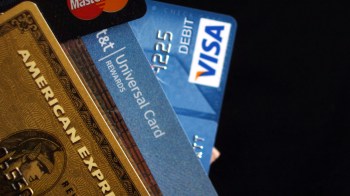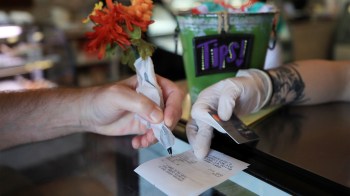Credit cards often sell us on spending
TEXT OF INTERVIEW
KAI RYSSDAL: How you spend your money says a lot about you. Some of us like the immediacy of cash. Feel the pain now, not later. Others prefer the cushion of credit. And that cushion is what credit-card companies count on.
Behavioral economist Dan Ariely says it skews our perception of the spending.
Dan, good to have you back with us.
DAN ARIELY: Same here.
RYSSDAL: So, Dan, it is all just plastic, right? So what’s the relationship between our perception of plastic money and real money?
ARIELY: It turns out that credit cards have very important psychological factors that they tap into, and because of that, actually make us spend more money. The first one is something called “the pain of paying.” So think about the following: Imagine that you’ve finished a meal. And you pay at the end of the meal either with a credit card or with cash. Which one do you find more painful?
RYSSDAL: Oh, cash. No question about it, right? Because plastic is just plastic.
ARIELY: So it turns out that the big reason for this is that the timing of payment and consumption is different all of a sudden. So, to think about it, imagine that I had a restaurant and I decide to give you a great discount today. Every bite would only be 50 cents. And not only that, I will only charge you for the bites you take. So, I will sit next to you with my little notebook, and everytime you take a bite, I will mark a “V” on my notebook and charge you 50 cents for that bite. How much fun will that meal be?
RYSSDAL: Yeah, not very much fun. And it’s going to be short, too, because I’m going to take, like, four bites and I’m going to be done.
ARIELY: So what this tells us, is that when it comes to payment, if you pay and consume at the same time — every bite is 50 cents — it creates pain of paying and, therefore, making the experience not as pleasant. From that perspective, credit cards are very effective in reducing the pain of paying.
But there’s another trick for credit cards. And the second trick is based on the idea that we think about money in terms of percentages, not in terms of absolute numbers. So here’s a simple example:
Imagine you are faced with a question of whether you want to buy a pen for $15. And the salesperson tells you you can buy the same pen — the same, exact pen — instead of for $15, for $8 if you walk five blocks down the street. Would you do it?
RYSSDAL: Uh, it depends on how I’m feeling. But maybe.
ARIELY: How about if you were buying a suit for $1,015. And the guy says you can buy the same suit for $7 less, for $1,008, if you walk five blocks down the road. Would you walk?
RYSSDAL: No. Not a chance. I stay right where I am.
ARIELY: And that’s because we think about money in percentages, not in absolute levels.
RYSSDAL: But you know what, though. I will drive an extra mile-and-a-half to save 4 cents on a gallon of gas.
ARIELY: A gallon of gas, and gasoline in general, has become such an important part of what we think of ourselves, and the efficiency and so on, that it has slightly different rules to it. And everybody also has different ways to indicate to themselves that they are financially frugal and reasonable — and this might be gas for you. But, in general, we think about money in terms of percentages. This is why you might look at tomatoes for a long time, thinking about whether you should buy the ones that are 20 cents cheaper. But when it comes to remodeling a house you would spend another $20,000 without twitching at all.
Now, credit cards, in some way, are like that. You have a big balance already — $1,500. So, spending $100 more is just a small part of it. So, with all of those factors, the pain of paying and the relativity — the percentage in thinking about money — makes credit cards much more powerful tools that get us to spend much more money.
RYSSDAL: So, to wrap this up on a personal note, I have to ask you how many credit cards you have in your wallet right now.
ARIELY: I have one credit card and one debit card.
RYSSDAL: Well, there you go.
ARIELY: Not too many. And I try to be reasonable about it.
RYSSDAL: He tries to be reasonable. Sometimes works. Sometimes doesn’t. Dan Ariely teaches behavioral economics at Duke University. His book on the subject is called, “Predictably Irrational.” Dan, thanks a lot.
ARIELY: My pleasure.
There’s a lot happening in the world. Through it all, Marketplace is here for you.
You rely on Marketplace to break down the world’s events and tell you how it affects you in a fact-based, approachable way. We rely on your financial support to keep making that possible.
Your donation today powers the independent journalism that you rely on. For just $5/month, you can help sustain Marketplace so we can keep reporting on the things that matter to you.


















